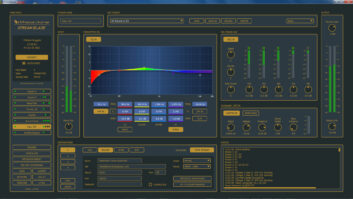Tests Show Potential, But Some in Broadcast Industry Call for More
Eliminating the need to keep track of radio listening hours with time-consuming diaries was one of Arbitron’s major goals when it began developing and testing the Portable People Meter listening tracking system in 1992.
In the decade since, Arbitron’s other major goal for the PPM has been to keep the much-debated ratings system afloat amid comments that the technology is too expensive, isn’t adequately tracking listening hours and could be too ephemeral to be successful in the real world.
Recent round
Though Arbitron has published details on what it called a “very successful” round of recent PPM tests in the Philadelphia Designated Market Area (DMA), the organization is being pushed to set up additional tests to secure the confidence of the radio industry while simultaneously looking for a partner to help bring an affordable PPM system to the U.S. radio market.
“Customers seem to have a strong positive reaction to the idea of metering radio in this way, (though) we know we have lots of questions to answer,” said Owen Charlebois, Arbitron president, U.S. Media Services.
With an investment of $100 million in the newest pager-like measurement device, Arbitron in 2000 began U.S. testing of the PPM technology at closely watched trials in Wilmington, Del., and Philadelphia.
Three hundred meters were passed out in the initial Wilmington deployment, followed by 1,500 meters when the trials were expanded to include the entire Philadelphia DMA.
Many, but not all, of the latest test results seemed to argue in PPM’s favor.
To Arbitron’s delight, the first three months of tests from 46 stations in the Philadelphia DMA seemed to address a problem that has hounded radio stations and advertisers for years: finding a way to gather more-accurate listener data.
The results released in May found that cumulative audiences were significantly higher for all radio stations compared to the diary method for the same listening period, with second- and third-favorite stations experiencing the largest increases.
This occurred because the PPM captures all radio listening time, even those minutes that people wouldn’t traditionally write down, said Thom Mocarsky, vice president, communications, Arbitron.
“It’s easy to remember the station you listen to the most,” he said. Second- and third-favorite stations experienced increases because the PPM was tracking all stations listened to, not just those on the top of the listeners’ minds.
“PPM records all stations listened to,” not just someone’s favorite station, he said.
The PPM also reported higher total-day average quarter hour audiences than the diary for persons in the age groups of 12-17, 18-24, 25-34, 35-44 and 45-54. But the diary revealed higher audiences for persons aged 55-64 and 65-plus. PPM audiences were equivalent for women 12-plus, but were lower than the diary for African-Americans.
In terms of hour-by-hour audiences, the PPM reported lower 12-plus audiences for morning drive, the so-called PPM “morning gap”; but it showed equivalent or slightly higher audiences than the diary in other dayparts. Persons 55-plus account for most, if not all of the difference in the morning gap, Arbitron said. Arbitron speculated that the 55-plus audience may be rounding up their average listening hours at that time of the day, though more research needs to be done to finalize an answer, Arbitron said.
As compared with the traditional diary results, total day AQH ratings were higher on average for 16 of 46 stations, the same for 22 stations and lower than the diary for eight stations (see Fig. 1).
To make these conclusions, Arbitron compared the test PPM data from the survey period of March 28 to April 24 to traditional diaries collected in the same period. The most recent figures also include comparisons to Arbitron radio estimates for the Philadelphia metro for the winter survey period of Jan. 3 to March 27.
More detailed findings are available at www.arbitron.com.
Citing concerns
A number of stations involved in the PPM tests have expressed concerns about both the methodology Arbitron is using and the technology, citing specifically the “in-studio headset effect.”
“It was like a digital delay,” said one program director based at a station in Wilmington.
Though Arbitron said the encoding system would not affect on-air broadcasts, some jocks noticed a small delay in their headsets.
“I did a morning show the very next day after the system was installed at our station, and it sounded like our traffic guy wasn’t working his mic close enough,” the Wilmington PD said. “We shut off the (encoding) box and the problem went away.”
Arbitron said it has since rectified the problem.
Other concerns involve the relatively small number of PPM participants in the test.
“The 300 meters in Wilmington represent only 25 percent of what normally we would see in returns on diaries,” the program director said.
“There are still so many unknowns. As much as we moaned and groaned about the diary system all these years, at least we know that devil.”
Other broadcasters, however, see the PPM as a boon for the industry.
“It’s a fabulous technology,” said Jerry Lee, president of WBEB(FM) in Bala Cynwyd, Pa. “It picks up listening automatically and will be great for showing cause and effect in advertising.”
Trouble ahead?
An ad-hoc committee of station group owners was organized in mid-June, led by RAB President and CEO Gary Fries, to share concerns about the PPM testing methodology.
“There are many ramifications to using the PPM technology, some positive and some that could be negative,” Fries said.
“But before the industry jumps into (embracing PPM technology), we want to evaluate more extensive results and have a little more voice in shaping (the process).”
According to Fries, the first step involves testing in additional markets. He said Philadelphia could present a unique situation that might not give reliable data, he said.
The ad-hoc group also is calling for additional side-by-side tests between PPM data and traditional Arbitron diaries.
The committee has expressed concern about other issues, including the potential price tag for the technology as well as the “morning gap.”
“There are just a lot of questions,” Fries said. “We need to have more confidence that we’ve looked at all aspects and avenues before the radio industry moves ahead.”
Charlebois has welcomed the committee’s comments, agreeing that “one of the most important issues is that we haven’t been able to quote a price for PPM,” Charlebois said. “We haven’t got a business proposition to be able to talk to our customers yet.”
However, the two sides seemed to disagree on the question of testing in additional markets. The issue was to be addressed when the organizations met in late July.
“Our position is to look at Philadelphia first,” Mocarsky said. “If, after looking at the data, if there is a belief that further tests are necessary, we would make a decision then. But we’re urging everyone to look at Philadelphia before jumping to the conclusion that we need another market.”
Arbitron also is hoping to form a joint venture with Nielsen Media Research, which is using the same PPM technology to track television ratings in the Philadelphia market.
According to Jack Loftus, senior vice president at Nielsen, the company hopes to make a decision about forming a joint venture with Arbitron before the end of the year.
“We are now evaluating the difference in the data between the PPM and what Nielsen’s meter diary is reporting,” Loftus said. “When we finish (that process), we’ll decide how best to proceed.”
Charlebois stressed the importance of such a joint venture, adding that two criteria must be met for PPM to be a success.
“The first is that Nielsen has to be a participant for the commercialization of PPM” due to the relatively costly process of deploying the technology nationwide, he said. “Secondly, we need financial support and participation from our customers (as well as the industry).”
Asked if Arbitron would consider a test in a different U.S. market, Charlebois said it was “too early to make a decision” but that Arbitron would consider such a move if more data were needed.
Arbitron also is focusing on the international marketplace, talking with broadcasters in Latin America, Europe, Asia and Australia about the technology.












